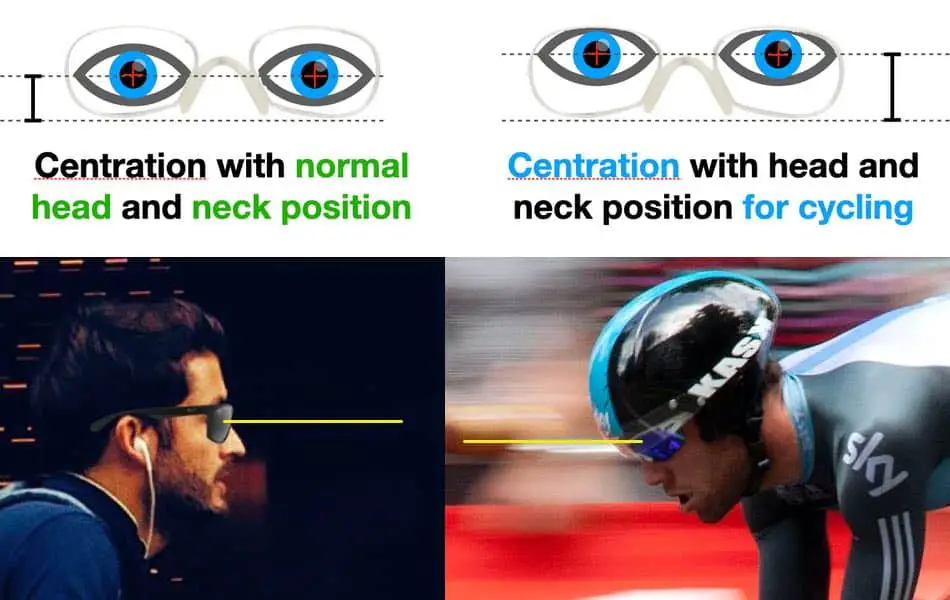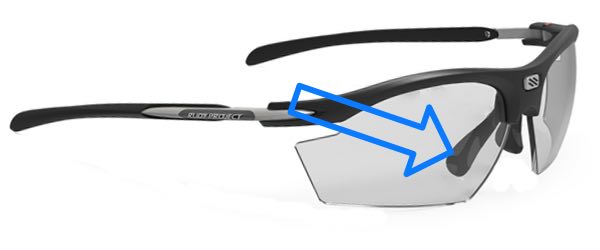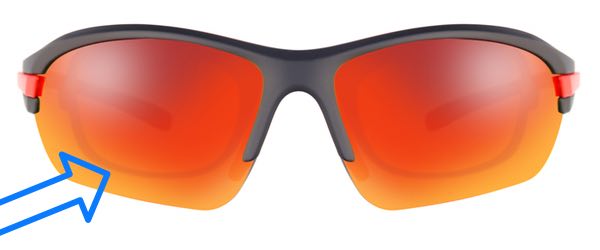The best progressive lenses are made with the individual head and neck position of the wearer in mind. Of course, those positions are highly dependent on the bike you ride.
Those special requirements on progressive lenses for cycling will get clear if you compare them to normal progressive lenses. Here in the picture below you can see a person on the left with sunglasses on and the position is pretty upright. Even though this person is also cycling the position changes a lot if you compare the left and the right picture of both cyclists.

The difference leads to a change of the centration of the progressive lenses depending on how much the cyclist leans forward. When the cyclists look through the lenses and lean forward the centration needs to be adjusted up to meet the perfect position where the wearer looks through.
What Position Do You Use Most Often When Cycling?
Your progressive lenses can only be optimized for one position. Not only in terms of how high the wearer should look through but also in regard to the prescription.
When you order normal progressive lenses in most cases you will have a pantoscopic tilt of around 8°. This means some frames sit in a little more or less inclined way on the nose but those lenses are always optimized for this setup. If the position changes let us say to 20° the prescription would not fit anymore.
Because the prescription corrects ideally for a tilt of 8°. What the manufacturer then needs to do is produce a compensated prescription with the head and neck positions in mind. Let us have look at what this actually means in a real-world example.
Prescription in the Testing Frame
| SPH | CYL | Axis | Add | |
| R | +4,00 | -2,00 | 180 | 1,50 |
| L | +4,00 | -1,00 | 90 | 1,50 |
Prescription in Your Glasses With Compensated Prescription Values
| SPH | CYL | Axis | Add | |
| R | +3,37 | -1,87 | 165 | 1,5 |
| L | +3,37 | -0,75 | 72 | 1,5 |
Those prescriptions look very different from one another but yet produce the same clear image. This is why it is very important to buy progressive lenses for cycling with compensated values. Of course, they are more price intense compared to normal progressive lenses. But with normal progressive lenses, you will probably not have the success you want.
If the lenses have not been made with the angles and distances of a sporty frame in mind chances are high you will end up with blurry vision when getting into your position for riding your bike. This is true if the prescription is built-in directly into the curved lenses or in a clip in solution. Because even if you choose to have the clip in usually the lenses in the clip sit in another angle as compared to a normal frame.
What You Should Know About Frame Selection to Get the Perfect Glasses for Cycling?
I highly recommend choosing a frame that has adjustable nose pads. Like this Rudy Project Rydon in the picture below. This way you can make sure it can be fitted to the needs of the cyclist. In most cases, this means the nose pads need to be positioned more narrow than normal. This way the glasses will sit a little higher and give you a more clear field of view while cycling in a lean-forward position.

When it comes to sports wrapped around glasses they will give you a better ability to see what is going on around you in addition to the superior UV protection compared to standard glasses. The distance between your eyes and the lenses should be as short as possible. This will give you wider fields of view with your progressive lenses. Here are my recommended frames:
- Head Pro Challenger
- Rudy Project Rydon
- Sziols X Kross
Progressive Lens Manufactures for Cycling We Had Great Experiences With
- Shamir
- Stratemeyer
Generally speaking a progressive lens with a shorter corridor oftentimes works great when using them especially for cycling. No matter if they are built in a curved fashion or in a clip in solution.
Before I talked about how the lenses are tilted when you look through them while riding your bike. The data I told you about the 20° of tilt are hard facts but the experienced optician will always have to average out this value. Otherwise, it would be possible you get blurry vision if you get in an upright position.
In most cases, this is the best solution. Because usually, it is better to be able to have a good visual acuity in looking at the distance upright and while you lean forward instead of having excellent vision just in one of those situations.

When we talk about compromises and how to optimize the lenses with the experience of your optician. In most cases, the Add value can be lower compared to your normal progressive lenses. This will give you less blur in the lower periphery of the lenses and an easier time adapting to your new progressives for cycling.
But you need to hold things a little further away from you compared to your normal progressives. Usually, this is no problem especially not when the lighting outside is excellent.
We have different manufacturers when it comes to progressive lenses. And there are definitely more that could manufacture those lenses than mentioned here in this article. But I will focus on two manufacturers here. Looking back from my experience Shamir has the most possibilities to produce lenses that are big very curved and in a big variety of tints.
This of course is great. Stratemeyer in Germany is also a great partner to contact when it comes to those special lenses. We oftentimes use them as a partner for more extreme clip-in solutions. Because they are able to produce clip-in prescriptions up to minus 15 diopters which is outstanding.
Of course, this information always needs to be seen in combination with your pupillary distance and the height the lenses need to be centered in.
Ok, now you have all the information you need to make a good decision. So go outside into a shop that has a selection of sporty frames and ask the optician about the possibilities. Do you like curved lenses more that have the prescription directly built into them? Or do you prefer a clip in solution that restricts your field of view a little (depending on the clip that comes with the frame).
I am personally a big fan of the curved lenses with your prescription. But the clip-ins have a big benefit. In most cases, frames for cycling will have a second pair of lenses that come with it. Usually, this means you get lenses with a darker tint and a lighter tint.
This way you have an interchangeable solution and you can switch if the tint of the lenses seems to be too dark or too light. You could even get a third pair and switch lenses for maximum contrast depending on where you ride your bike and when you want to do it.
Interchangeable lenses usually cost around 50$ per pair. If you order curved lenses with your prescription 550$ is a more realistic price. Depending on the options this may vary. Of course, you could switch both but most people go with the clip in solution if they want to have the ability to switch between tints.
I wish you a great day.
